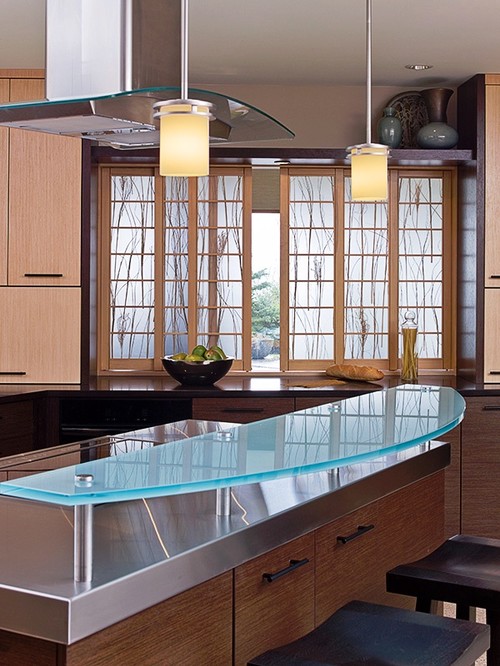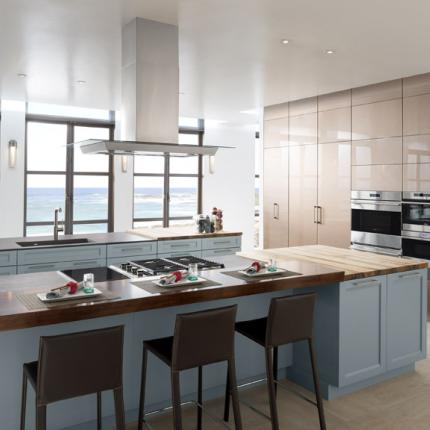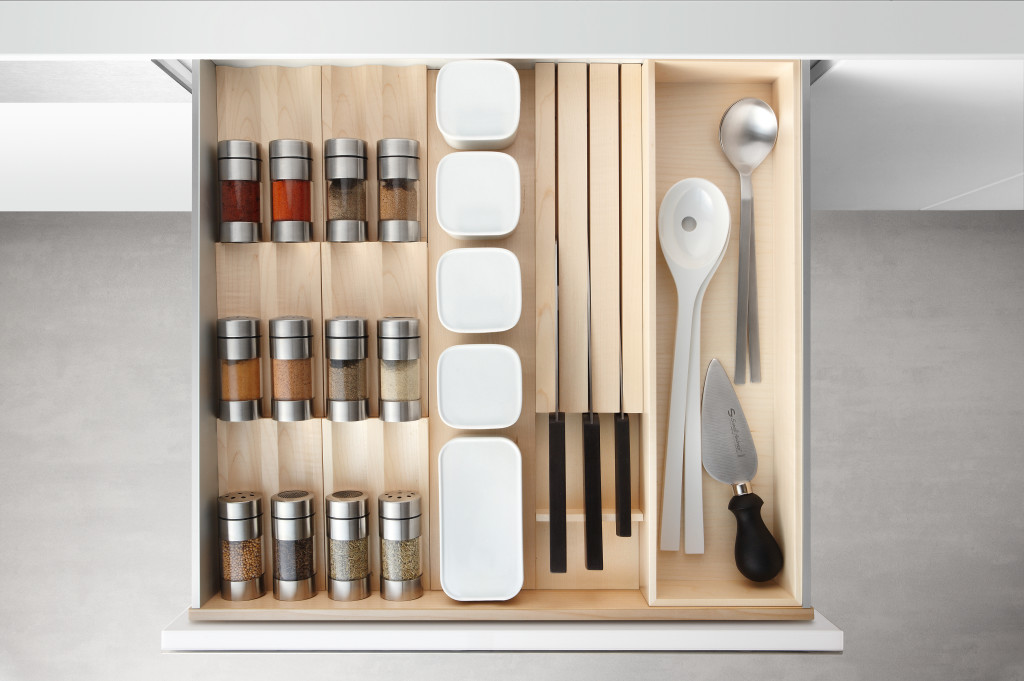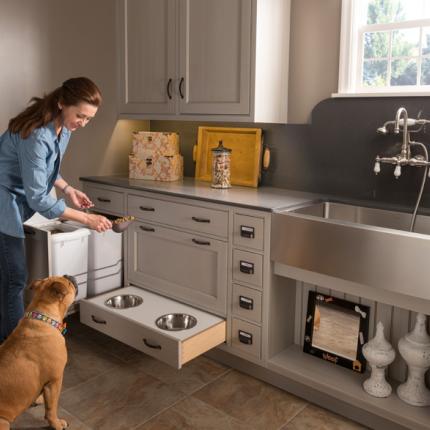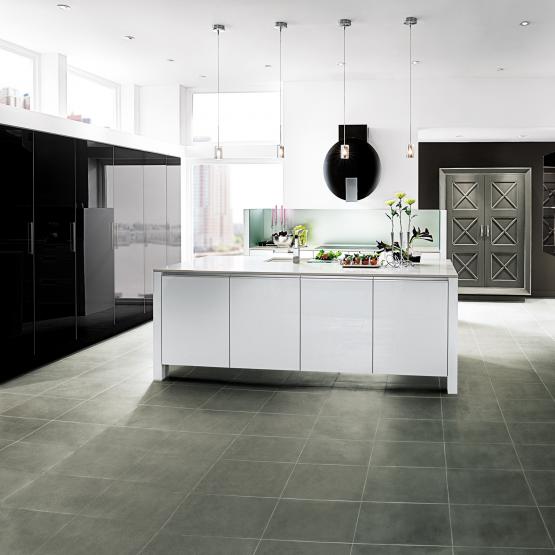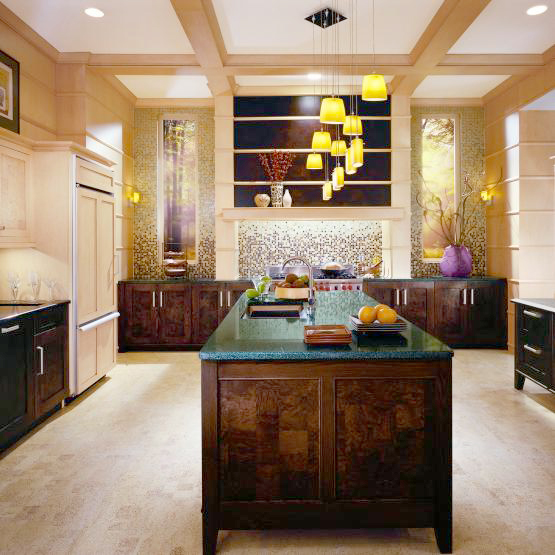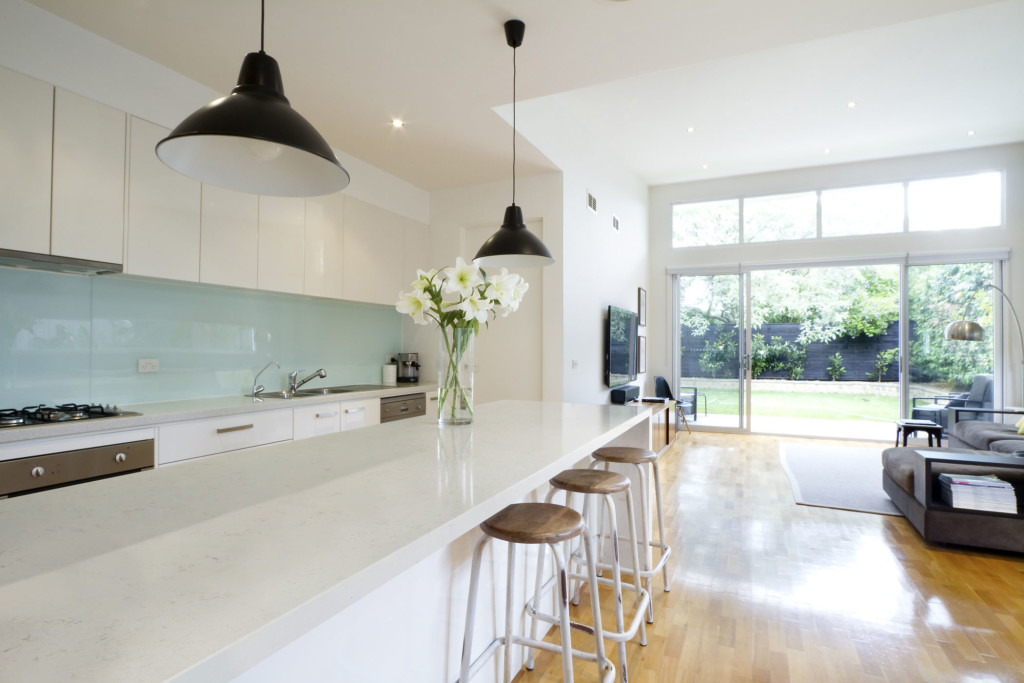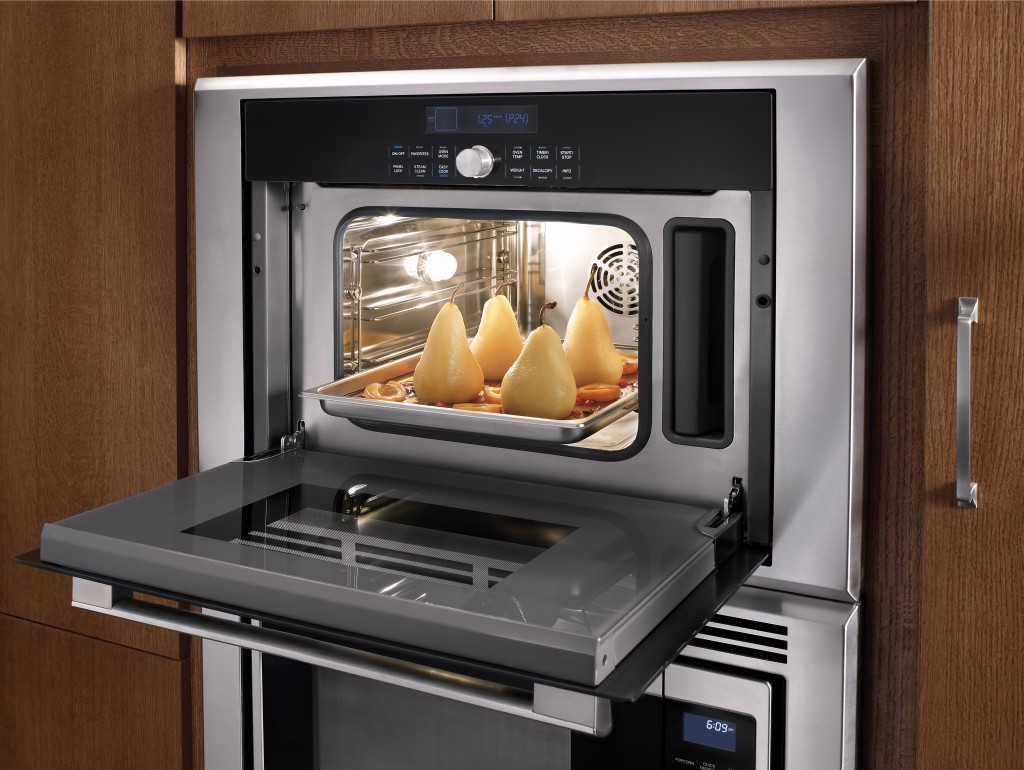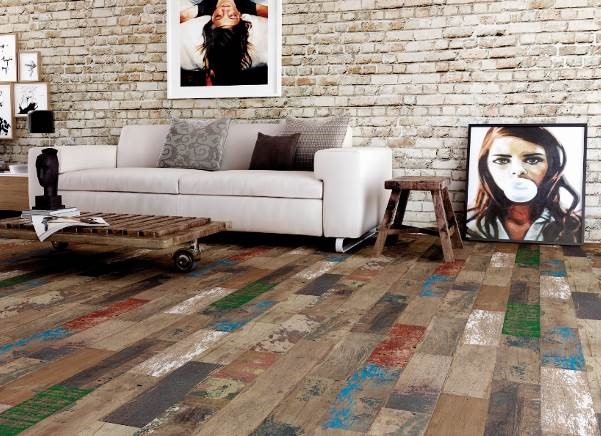Open shelves, especially floating shelves happen to be all the rage at the moment, should you or shouldn’t you? I often hear concerns about neatness. Do we really want to see it all? Maybe we do. Open shelves can greatly increase efficiency in the kitchen. Having our most used dishes, utensils and ingredients displayed and at our finger tips is very tempting! This is how the chefs do it and there is even a term for it in French.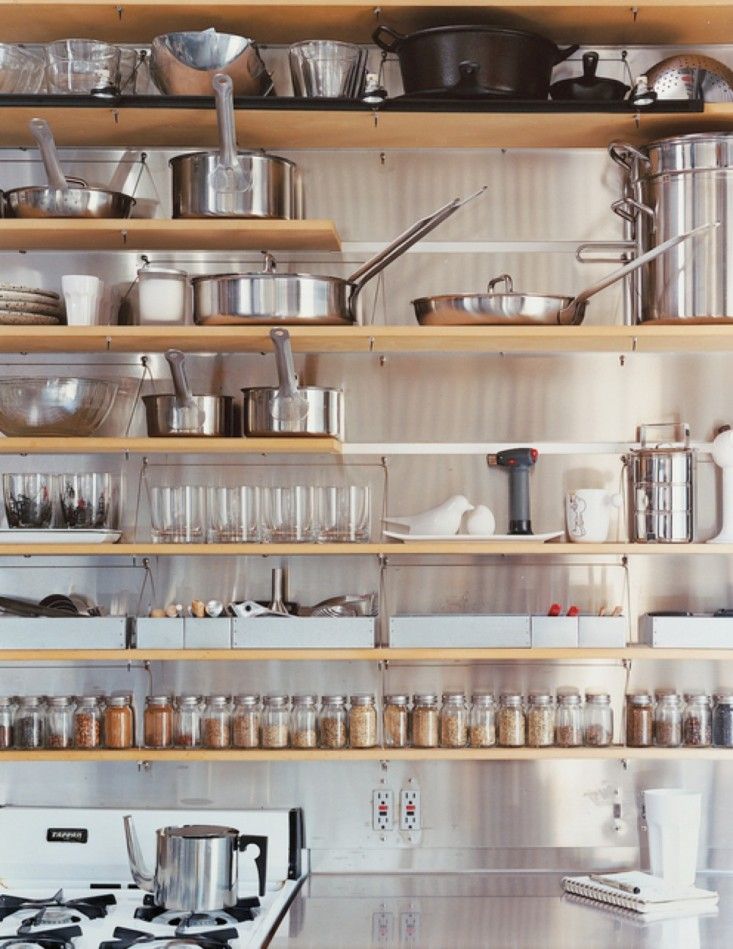 Mise en place is a French culinary phrase which means "putting in place", as in set up. It is used in professional kitchens to refer to organizing and arranging the ingredients and items that a cook will require for preparing the menu items of the day. We can also apply this concept in our own kitchens. Here's an interesting story I came across on NPR about Mise en place. Listen and you will discover the perfect French pronunciation!
Mise en place is a French culinary phrase which means "putting in place", as in set up. It is used in professional kitchens to refer to organizing and arranging the ingredients and items that a cook will require for preparing the menu items of the day. We can also apply this concept in our own kitchens. Here's an interesting story I came across on NPR about Mise en place. Listen and you will discover the perfect French pronunciation!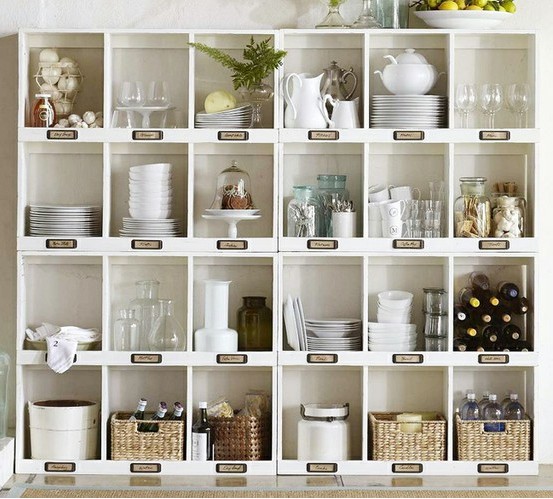 Usually storage space in the kitchen is too dear to squander on an area strictly for show so I urge you to incorporate an open shelf or open cabinet only if it will be useful as well as visually interesting. When you get right down to it, kitchens are comprised of boxes and row after row of doors can get pretty boring. I like to add some variety with open shelves and glass doors.
Usually storage space in the kitchen is too dear to squander on an area strictly for show so I urge you to incorporate an open shelf or open cabinet only if it will be useful as well as visually interesting. When you get right down to it, kitchens are comprised of boxes and row after row of doors can get pretty boring. I like to add some variety with open shelves and glass doors.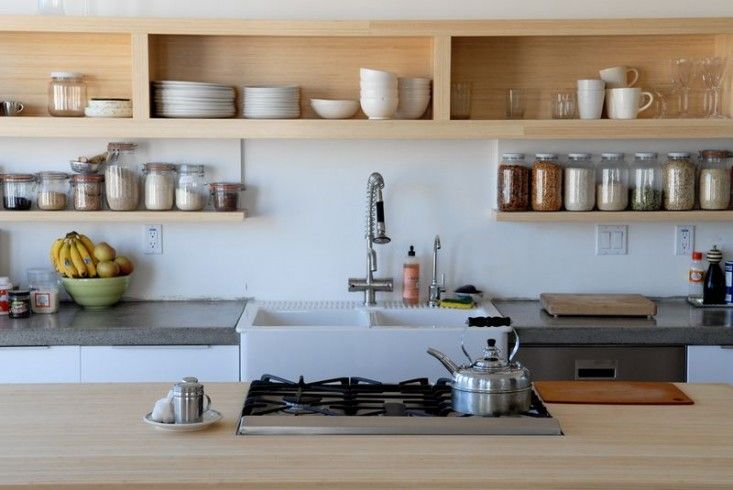 That said, if you do have a collection that you love to gaze upon and showcase , open shelves are perfect is hard to reach areas such as high up or on the far side of a peninsula
That said, if you do have a collection that you love to gaze upon and showcase , open shelves are perfect is hard to reach areas such as high up or on the far side of a peninsula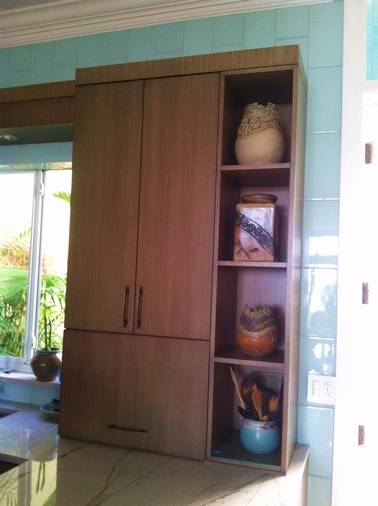 This client is a talented potter. What better way to show off her work? Easy to get to for dusting when you’re on the other side of the peninsula but this area is not really accessible when you’re on the working side of the kitchen.
This client is a talented potter. What better way to show off her work? Easy to get to for dusting when you’re on the other side of the peninsula but this area is not really accessible when you’re on the working side of the kitchen.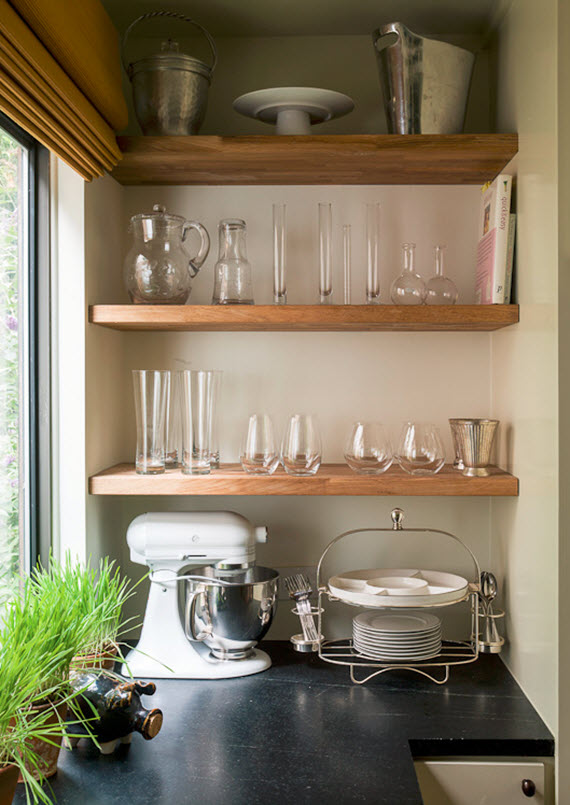 http://www.shelterness.com/pictures/open-shelves-on-a-kitchen-30.jpeg
http://www.shelterness.com/pictures/open-shelves-on-a-kitchen-30.jpeg
Eva Hesse: The Artist and The Kitchen
THE ARTISTThe biggest trend in design today is "personalization", the late painter and sculptor Eva Hesse spoke of personalization before many of us were even born! She was speaking in terms of her art when she said,"It just seems to me that "personal" in art, if really pushed, is the most valued quality & what I want so much to find in & for myself." Eva Hesse, succumbed to a brain tumor in 1970 at the age of 34. Although she only produced art for 10 years, from 1960 to 1970, she is known for her pioneering work in latex, fiberglass and plastic. She was part of an art movement in the 1960s known as postminimalism. Hesse was among the first artists of the 1960s to experiment with the fluidity of the organic shapes of nature. She used modern materials to portray organic forms including grid patterns and repetition. These themes were often found in minimalism, but Hesse typically made her works by hand while her contemporaries were using machines. This practice introduced a human element into her art.
Eva Hesse, succumbed to a brain tumor in 1970 at the age of 34. Although she only produced art for 10 years, from 1960 to 1970, she is known for her pioneering work in latex, fiberglass and plastic. She was part of an art movement in the 1960s known as postminimalism. Hesse was among the first artists of the 1960s to experiment with the fluidity of the organic shapes of nature. She used modern materials to portray organic forms including grid patterns and repetition. These themes were often found in minimalism, but Hesse typically made her works by hand while her contemporaries were using machines. This practice introduced a human element into her art.
 A new documentary about her life was released earlier this year and premiered at The Whitney Museum in New York City back in May. I can't wait to see it! Below is a clip."Eva Hesse" feature doc Intro from Tracing the Rope on Vimeo.THE KITCHENI wonder what Eva's kitchen would look like. I could find no photo to give me clues but when I think of Eva I think of organic elements, natural finishes, bold shapes and even a touch of the absurd, which she loved! Here are some kitchens evocative of Eva.
A new documentary about her life was released earlier this year and premiered at The Whitney Museum in New York City back in May. I can't wait to see it! Below is a clip."Eva Hesse" feature doc Intro from Tracing the Rope on Vimeo.THE KITCHENI wonder what Eva's kitchen would look like. I could find no photo to give me clues but when I think of Eva I think of organic elements, natural finishes, bold shapes and even a touch of the absurd, which she loved! Here are some kitchens evocative of Eva.

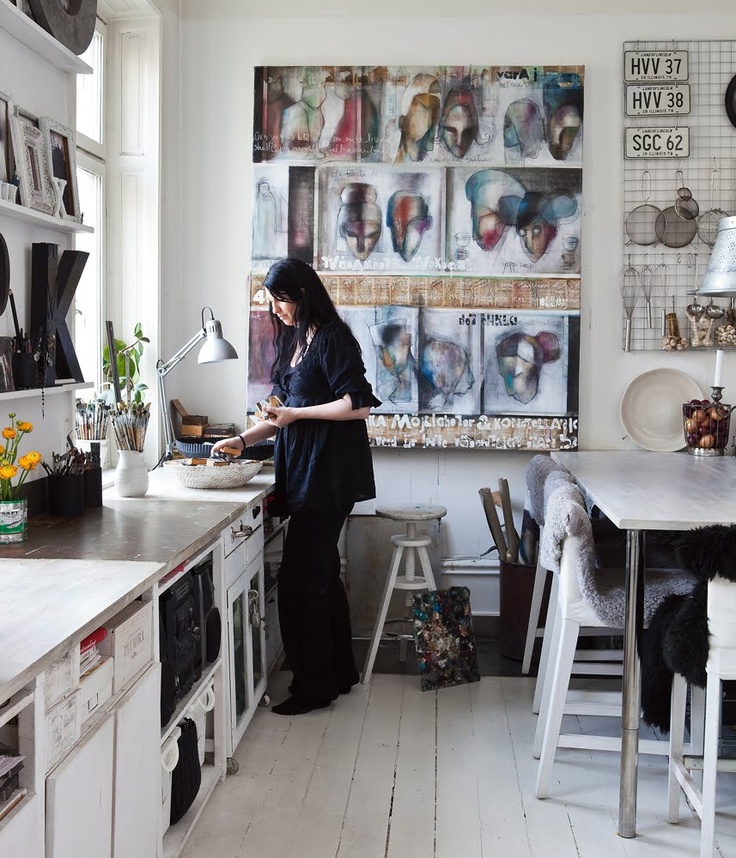 On my morning walks, whenever I pass this spot I always look up and think of Eva.
On my morning walks, whenever I pass this spot I always look up and think of Eva.
5 Elements of an Artful Kitchen
Summer projects are underway in South Florida! In fact, it's the height of the busy season for most design professionals here.
I don't have to tell you that a new kitchen is a big investment, in fact the kitchen is the most expensive renovation you're ever likely to undertake. It stands to reason that you'd want a kitchen that is tailor-made for you whether you can afford custom or not. This is what we're all about at Artful Kitchens.
The concept of an "artful kitchen" has many different facets. It is not just about budget or the amount of space you have but the skill you employ using what is available to you. Here are five tips to consider along with some visual inspiration featuring products I saw this year at the Kitchen & Bath Industry (KBIS) trade show in Las Vegas. Implement these with style and confidence and you will be the proud owner of an artful kitchen!
1. Flawless Function
I'm all about artistic expression but a major part of creativity in the kitchen comes from devising flawless function. This quality is not something you see but something you can experience if artfully accomplished. When I say function, I mean work centers comprised of cooking, clean up and food prep areas.
Those are the basics but you could have more such as a beverage center (think coffee, tea, wine), a computer station or a baking center. If you have a two-cook kitchen, your layout should be designed so that any one of the major functions can be performed without anyone getting underfoot.
Following the guidelines set by the NKBA is a must to make sure all clearances are adequate. Sometimes we don't have a lot of choice about where to locate our sink or appliances but we can organize our utensils, dishes, pots and food items in a more efficient way. Don't forget the more flawlessly your kitchen functions the safer it is. You don't have to be an expert at this, just think about how you use your kitchen so that you will be a good collaborator when it comes time to work with a professional.
2. Personalization
This is, without a doubt, the biggest movement in the design world. An artful kitchen is your own personal statement customized to the way you live. It could be a steam oven because healthy eating is your passion or it could be a lovely furniture piece with glass doors to display your grandmother's china. Include the colors you love. Even though you must be mindful of your budget (everyone has one), strive to retain the essence of what you see as your dream kitchen.
3. Harmony
Harmony is one of the principles of design and a must for your kitchen. Whenever I design a two-toned kitchen I like to ensure that different finishes and details are carried through the space to create a cohesive whole. It's about how the floor relates to the cabinets and how the cabinet hardware relates to the faucet. You get the picture! It does not mean that everything has to match perfectly, it means elements should relate to and complement each other. It also does not mean that every element has to be perfectly symmetrical. In fact, consider this permission NOT to be! I find that the best rule of thumb is to follow the architecture and style of the home you're in. If, for example, the kitchen window is way off center you should work with that not against it. Never force solutions by sacrificing function.
4. Focal Point
Every piece of great artwork has a focal point. It is the "star of the show", so to speak. In a kitchen it can be a sculptural range hood, a granite counter with big bold movement or actually a piece of art! It is the item that makes you say WOW when you enter the kitchen. Just remember less is more here. One great focal point is probably enough. Too much and the statement gets lost. Less is definitely more.
5. Texture
The element of texture involves at least two of our senses, touch and sight. The textures you are likely to come across include the glossy finishes popular in contemporary design, prominent wood grains which can be traditional or modern and smooth honed surfaces that are more matte. A flat slab cabinet door is a great choice if you plan to use a wood with a lot of pattern and graining. In this case the material is the decorative element of the cabinet. On the other hand, if you are traditional and you are using white cabinets you can select a door with some molding or detail. Also let the wild patterns either be on your cabinets or on your counter, both would be busy and distracting.
This is only the tip of the iceberg, so to speak. There are many more tricks and methods to create an artful kitchen. What are yours? Please keep in touch and contact me. Whether you need a quick consult or a full design layout I can help in person or virtually.
I'm located in the West Palm Beach area, so if you're local I can also help you shop for your kitchen products.
Tile Tuesday: Beauty & Knowledge
Welcome the the third installment of Tile Tuesday. If you missed the last two you can catch them here and here.The second half of my adventure with Tile of Spain took us to Valencia, the location of Cevisama, annual trade show held to showcase the latest innovations introduced by the Spanish tile industry. Attending Cevisama was an introduction to a whole world of possibilities! If you’ve been following Tile Tuesday, you already know that ceramic tile is a part of the Spanish culture dating back to Roman and Moorish times. Tile is nothing new but the uses and innovations in the ceramic industry certainly are! In the coming weeks we’ll talk about some of the big trends I saw that you can incorporate into your own kitchen.
Attending Cevisama was an introduction to a whole world of possibilities! If you’ve been following Tile Tuesday, you already know that ceramic tile is a part of the Spanish culture dating back to Roman and Moorish times. Tile is nothing new but the uses and innovations in the ceramic industry certainly are! In the coming weeks we’ll talk about some of the big trends I saw that you can incorporate into your own kitchen. Before we do that let’s cover some good to know, sometimes misunderstood, facts about tile. For your viewing pleasure I have inserted a little eye candy to keep you on your toes!WHAT IS IT?Ceramic tile is a perfect balance of the classical elements of earth (clay), air, water and fire. All are involved in its creation. All tile is made of either red or white clay.
Before we do that let’s cover some good to know, sometimes misunderstood, facts about tile. For your viewing pleasure I have inserted a little eye candy to keep you on your toes!WHAT IS IT?Ceramic tile is a perfect balance of the classical elements of earth (clay), air, water and fire. All are involved in its creation. All tile is made of either red or white clay.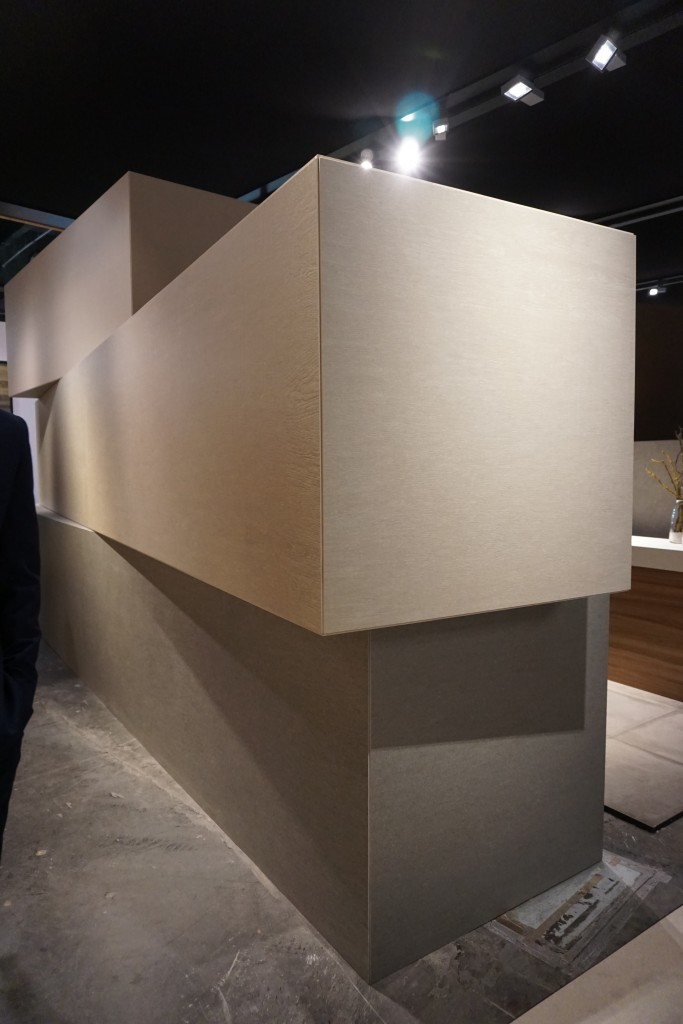 CERAMIC, PORCELAIN OR BOTH?One big question I get regards porcelain vs. ceramic. Guess what? Porcelain tiles ARE ceramic tiles. There is only one technical difference. A tile must have a water absorbtion rate of .05 to be classified as porcelain.
CERAMIC, PORCELAIN OR BOTH?One big question I get regards porcelain vs. ceramic. Guess what? Porcelain tiles ARE ceramic tiles. There is only one technical difference. A tile must have a water absorbtion rate of .05 to be classified as porcelain. 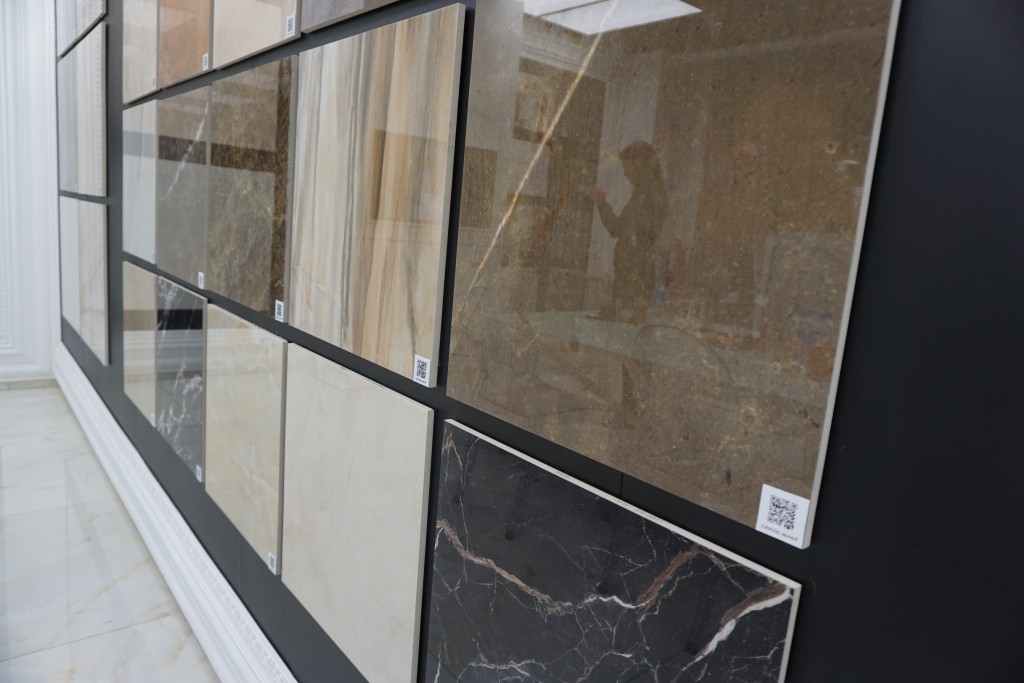 Typically porcelain tiles are denser, less porous and as a result more durable than other ceramics. You can also get them “rectified” which means crisp sharp perfectly squared edges that mean a tight fit with minimal grout lines.IS PORCELAIN THE SAME COLOR ALL THE WAY THROUGH?In the past I believed that a porcelain tile was the same color all the way through so that a small chip would be no big deal but I learned that is not always true. You CAN get something called “through-body porcelain” which means that if the tile is not glazed, the color and texture are consistent all the way through the tile. However porcelain tiles can also have surface glazes and textures that are not “through-body”.
Typically porcelain tiles are denser, less porous and as a result more durable than other ceramics. You can also get them “rectified” which means crisp sharp perfectly squared edges that mean a tight fit with minimal grout lines.IS PORCELAIN THE SAME COLOR ALL THE WAY THROUGH?In the past I believed that a porcelain tile was the same color all the way through so that a small chip would be no big deal but I learned that is not always true. You CAN get something called “through-body porcelain” which means that if the tile is not glazed, the color and texture are consistent all the way through the tile. However porcelain tiles can also have surface glazes and textures that are not “through-body”.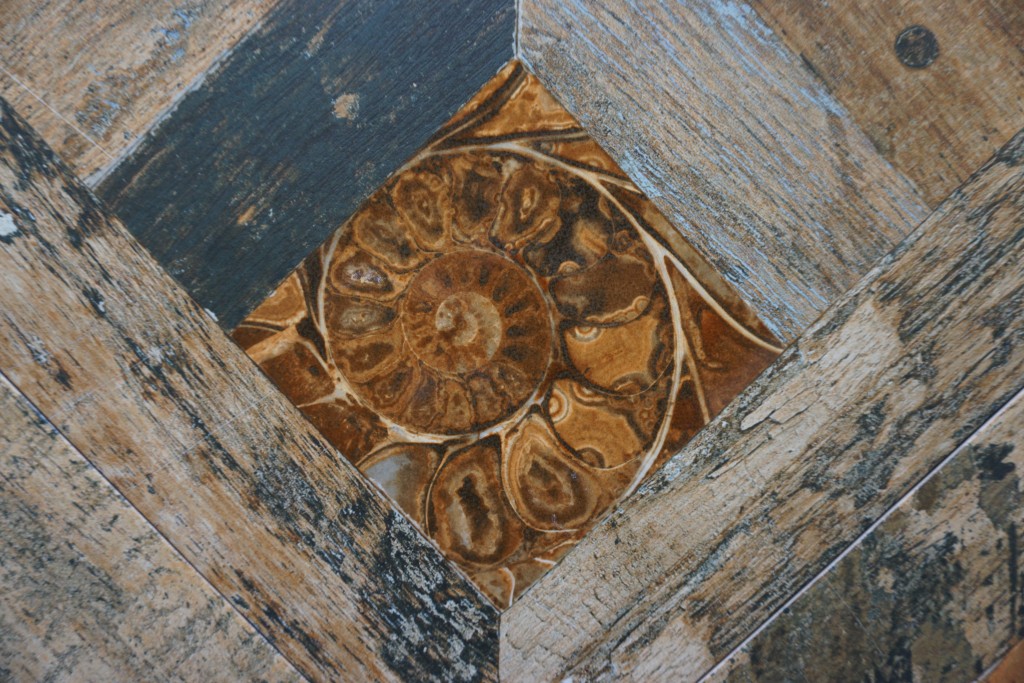 WHERE DOES IT GO?Tiles used for exterior applications are porcelain but not all porcelain tiles are recommended to be used outside. Generally you can put just about any type of tile on the wall but you’re much better off with porcelain on the floor for durability. Remember, although beautiful, glossy finishes are always more slippery than honed, or matte finishes. Got it? Good. Since you made it all the way to the end, I have a special treat for you.
WHERE DOES IT GO?Tiles used for exterior applications are porcelain but not all porcelain tiles are recommended to be used outside. Generally you can put just about any type of tile on the wall but you’re much better off with porcelain on the floor for durability. Remember, although beautiful, glossy finishes are always more slippery than honed, or matte finishes. Got it? Good. Since you made it all the way to the end, I have a special treat for you.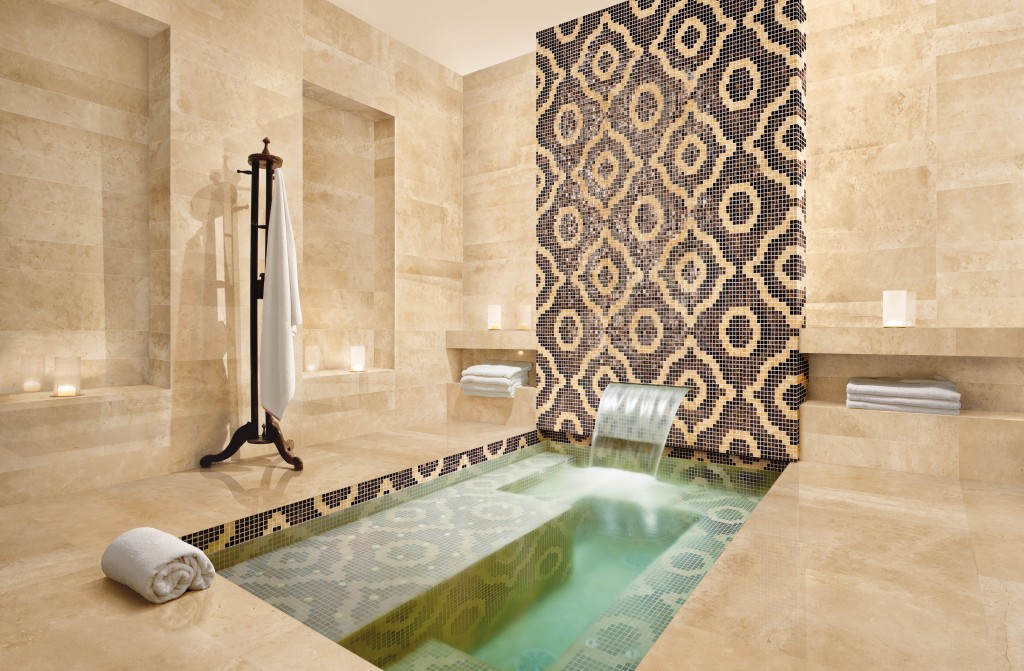 Next Tile Tuesday: Uncovering Valencia with Tile of Spain, perhaps another video slideshow??
Next Tile Tuesday: Uncovering Valencia with Tile of Spain, perhaps another video slideshow??
Spanish Style 2015
As you are reading this I'm probably winging my way across the Atlantic, heading to the Passport to Creativity 2015 event courtesy of Tile of Spain. We will be exploring Seville and then on to Valencia to attend Cevisama, Spain's international tile trade fair showcasing the latest in tile products and design trends. Follow me on FaceBook, Instagram and Twitter for live reports and I'll be recapping all right here upon my return. For now, here's a sneak preview of some of what we'll be seeing (just to get you in the mood).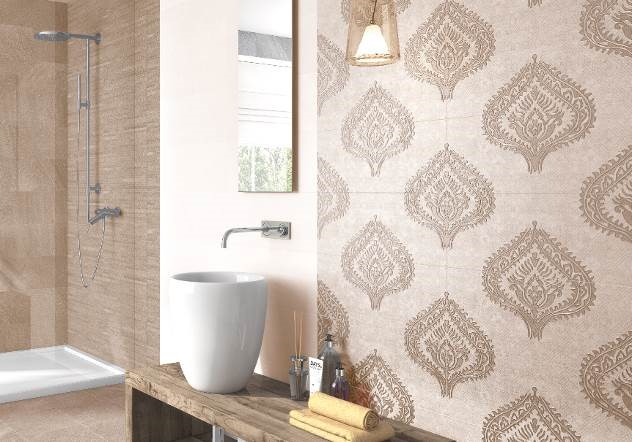
Color palettes include monochromatic color schemes where one hue is carried throughout with subtle changes in texture and pattern. This is a great way to tie a room together creating a harmonious whole. Looks like "greige" strikes again here!
But if you're not so subtle there are lots of bright color choices too! I'm loving the originality, not to mention the forgiving nature of this new porcelain tile! Organically inspired tile is taking a cue from nature for a very authentic wood look. In addition, there are lots of choices for mosaics. The point is all the elements are there for you to make a unique and very personal statement with tile.
Click here for more info about Tile of Spain and where you can get the latest tile.
Getting Creative at Cavastone
Time to switch from "turkey talk" to tile! Hope you had a great holiday. If you haven't found the new Kitchens for Living page on Facebook, please check it out and give me some love (ok I'll settle for a like). Today I'd like to highlight a local resource that you should definitely know about if you live in South Florida.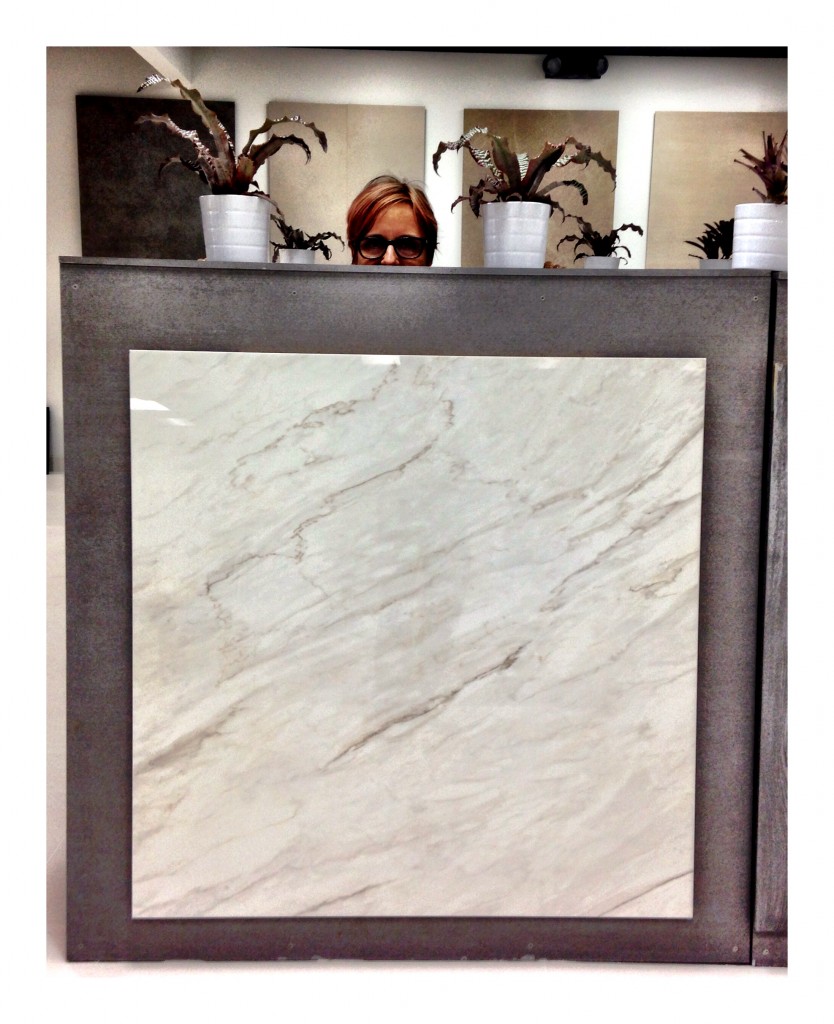 Cavastone is located in Boca Raton. I've worked with them before but I was recently in the neighborhood so I decided to make a pit stop and check out the latest in the world of tile. The showroom is stunning, sophisticated, and well lit which allows you to view the products to their full advantage. I was most impressed with the options they have for porcelain tile but there is also a large assortment of granite and marble slabs.
Cavastone is located in Boca Raton. I've worked with them before but I was recently in the neighborhood so I decided to make a pit stop and check out the latest in the world of tile. The showroom is stunning, sophisticated, and well lit which allows you to view the products to their full advantage. I was most impressed with the options they have for porcelain tile but there is also a large assortment of granite and marble slabs.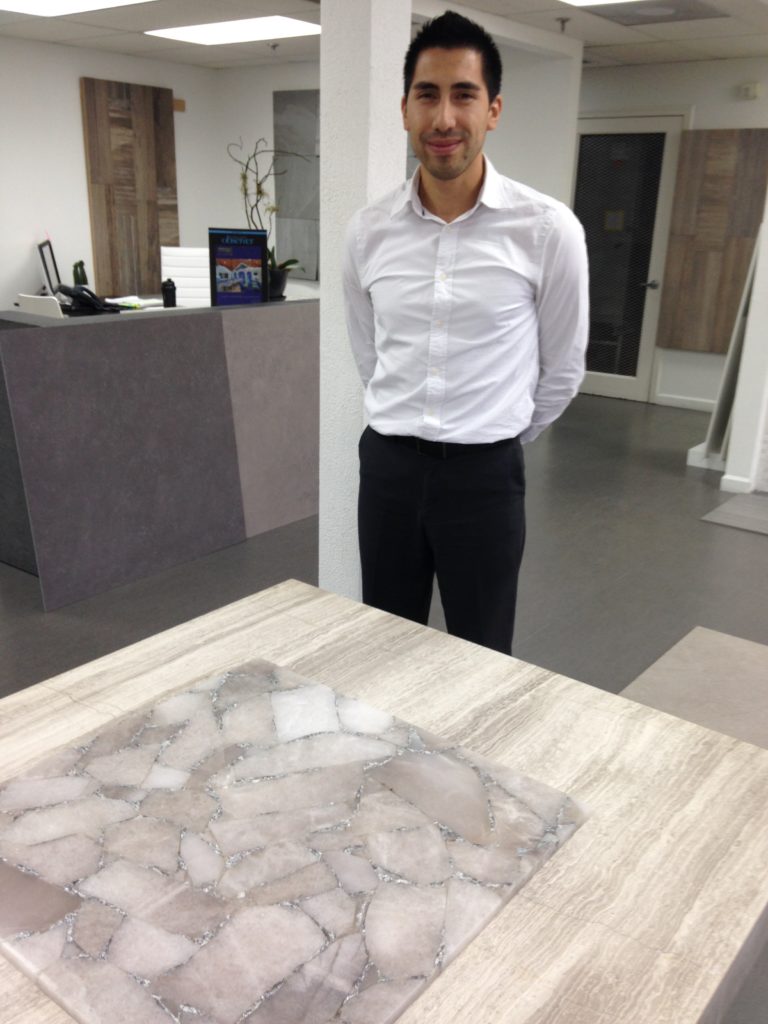 The tile above is gorgeous! It's a natural semi-precious stone accented with silver! Makes me think of a decadent boudoir or dressing area.
The tile above is gorgeous! It's a natural semi-precious stone accented with silver! Makes me think of a decadent boudoir or dressing area.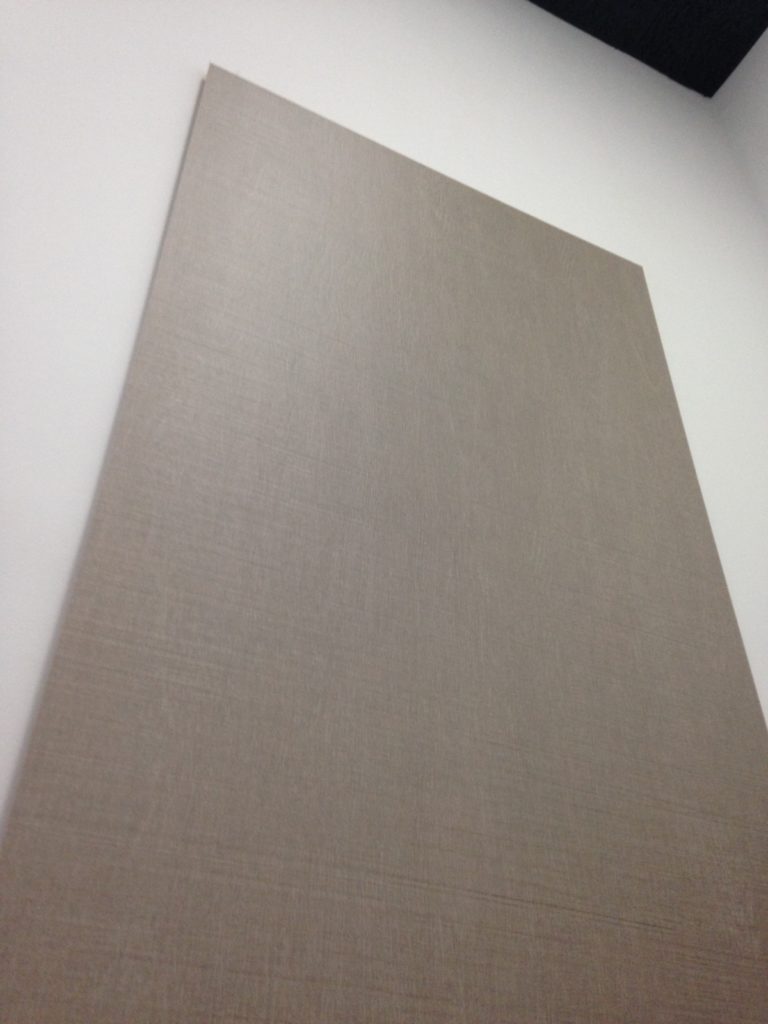
 Digital printing technology allows for an infinite number of options when it comes to porcelain tile. They've got the natural look down! The nice thing is if you ever need more it can be made for you. Those large sizes (see top) also come in 25" by 25" in case your abode is not quite that large.
Digital printing technology allows for an infinite number of options when it comes to porcelain tile. They've got the natural look down! The nice thing is if you ever need more it can be made for you. Those large sizes (see top) also come in 25" by 25" in case your abode is not quite that large.  This dimensional look is also a big trend, used for walls in both interior and exterior applications. You can find all Cavastone info right here on the Kitchens for Living Local Resources page. If you've got a great local resource clue me in. I'd love to hear about it!
This dimensional look is also a big trend, used for walls in both interior and exterior applications. You can find all Cavastone info right here on the Kitchens for Living Local Resources page. If you've got a great local resource clue me in. I'd love to hear about it!

